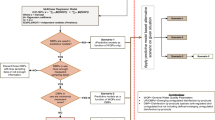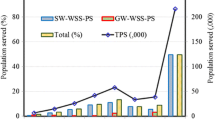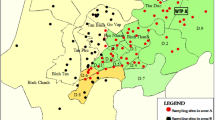Abstract
Among all the organic disinfection by-products (DBPs), only trihalomethanes (THMs) and haloacetic acids (HAAs) are regulated in drinking water, while most DBPs are not. Very little information exists on the occurrence of non-regulated DBPs, particularly in small water systems (SWS). Paradoxically, SWS are more vulnerable to DBPs because of a low capacity to implement adequate treatment technologies to remove DBP precursors. Since DBP analyses are expensive, usually SWS have difficulties to implement a rigorous characterization of these contaminants. The purpose of this study was to estimate non-regulated DBP levels in SWS from easy measurements of relevant parameters regularly monitored. Since no information on non-regulated DBPs in SWS was available, a sampling program was carried out in 25 SWS in two provinces of Canada. Five DBP families were investigated: THMs, HAAs, haloacetonitriles (HANs), halonitromethanes (HNMs), and haloketones (HKs). Multivariate linear mixed regression models were developed to estimate HAN, HK, and HNM levels from water quality characteristics in the water treatment plant, concentrations of regulated DBPs, and residual disinfectant levels. The models obtained have a good explanatory capacity since R 2 varies from 0.77 to 0.91 according to compounds and conditions for application (season and type of treatment). Model validation with an independent database suggested their ability for generalization in similar SWS in North America.



Similar content being viewed by others
References
Abdullah, A. M., & Hussona, S. E. (2013). Predictive model for disinfection by-product in Alexandria drinking water, northern west of Egypt. Environmental Science and Pollution Research, 120, 7152–7166.
Adams, C., Timmons, T., Seitz, T., Lane, J., & Levotch, S. (2005). Trihalomethane and haloacetic acid disinfection by-products in full-scale drinking water systems. Journal of Environmental Engineering, 131, 526–534.
Akaike, H. (1973). Information theory and extension of the maximum likelihood principle. In N. B. Petrov & F. Csaki (Eds.), Proceeding of the Second International Symposium on Information Theory (pp. 267–281). Budapest: Akademia Kiado.
Bayless, W., & Andrews, R. C. (2008). Biodegradation of six haloacetic acids in drinking water. Journal of Water and Health, 6, 15–22.
Bond, T., Huang, J., Templeton, M. R., & Graham, N. (2011). Occurrence and control of nitrogenous disinfection by-products in drinking water—a review. Water Research, 45, 4341–4354.
Bond, T., Templeton, M., Kamal, N. H. M., Graham, N., & Kanda, R. (2015). Nitrogenous disinfection byproducts in English drinking water supply systems: occurrence, bromine substitution and correlation analysis. Water Research, 85, 85–94.
Bougeard, C. M. M., Goslan, E. H., Jefferson, B., & Parsons, S. A. (2010). Comparison of the disinfection by-product formation potential of treated waters exposed to chlorine and monochloramine. Water Research, 44, 729–740.
Bull, R. J., Rice, G., & Teuschler, L. K. (2009). Determinants of whether or not mixtures of disinfection by-products are similar. Journal of Toxicology and Environmental Health, 72, 437–460.
Carlson, M., & Hardy, D. (1998). Controlling DBPs with monocholoramine. Journal of American Water Works Association, 90, 95–106.
Chang, H. H., Tung, H. H., Chao, C. C., & Wang, G. S. (2010). Occurrence of haloacetic acids (HAAs) and trihalomethanes (THMs) in drinking water of Taiwan. Environmental Monitoring and Assessment, 162, 237–250.
Chen, B., & Westerhoff, P. (2010). Predicting disinfection by-product formation potential in water. Water Research, 44, 3755–3762.
Chowdhury, S., Champagne, P., & McLellan, P. J. (2009). Models for predicting disinfection byproduct (DBP) formation in drinking waters: a chronological review. Science of the Total Environment, 407(14), 4189–206.
Coulibaly, H. D., & Rodriguez, M. J. (2004). Development of performance indicators for small Quebec drinking water utilities. Journal of Environmental Management, 73, 243–255.
Crittenden, J. C., Rhodes Trussel, R., Hand, D. W., Howe, K. J., & Tchobanoglous, G. (2005). Water treatment: principles and design (2nd ed.). Wiley.
Croue, J.-P., & Reckhow, D. A. (1989). Destruction of chlorination byproducts with sulfite. Environmental Science & Technology, 23, 1412–1419.
Di Cristo, C., Esposito, G., & Leopardi, A. (2013). Modelling trihalomethanes formation in water supply systems. Environmental Technology, 34, 61–70.
Dore, M. H. I., Singh, R. G., Achari, G., & Khaleghi-Moghadam, A. (2013). Cost scenarios for small drinking water treatment technologies. Desalination and Water Treatment, 51, 3628–3638.
Edwards, J. E., Henderson, S. B., Struck, S., & Kosatsky, T. (2012). Characteristics of small residential and commercial water systems that influence their likelihood of being on drinking water advisories in rural British Columbia, Canada: a cross-sectional study using administrative data. Journal of Water and Health, 10, 629–649.
Fang, J., Ma, J., Yang, X., & Shang, C. (2010). Formation of carbonaceous and nitrogenous disinfection by-products from the chlorination of Microcystis aeruginosa. Water Research, 44, 1934–1940.
Gan, W., Guo, W., Mo, J., He, Y., Liu, Y., Liu, W., Liang, Y., & Yang, X. (2013). The occurrence of disinfection by-products in municipal drinking water in China’s Pearl River Delta and a multipathway cancer risk assessment. Science of the Total Environment, 447, 108–115.
Ged, E. C., Chadik, P. A., & Boyer, T. H. (2015). Predictive capability of chlorination DBP models. Journal of Environmental Management, 149, 253–262.
Golfinopoulos, S. K., Nikolaou, A. D., & Lekkas, T. D. (2003). The occurrence of disinfection by-products in the drinking water of Athens, Greece. Environmental Science and Pollution Research, 10, 368–372.
Guilherme, S., & Rodriguez, M. J. (2014). Occurrence of regulated and non-regulated disinfection by-products in small drinking water systems. Chemosphere, 117, 425–432.
Guilherme, S., & Rodriguez, M. J. (2015). Short-term spatial and temporal variability of disinfection by-products occurrence in small drinking water systems. Science of the Total Environment, 518-519, 280–289.
Health Canada. (2012). Guidelines for Canadian Drinking Water Quality.
Hu, J., Song, H., & Karanfil, T. (2010). Comparative analysis of halonitromethane and trihalomethane formation and speciation in drinking water: the effects of disinfectants, pH, bromide, and nitrite. Environmental Science & Technology, 44, 794–799.
Hua, G., & Reckhow, D. A. (2007). Comparison of disinfection byproducts formation from chlorine and alternative disinfectants. Water Research, 41, 1667–1678.
Hua, G., Reckhow, D. A., & Abusallout, I. (2015). Correlation between SUVA and DBP formation during chlorination and chloramination of NOM fractions from different sources. Chemosphere, 130, 82–89.
Karanfil, T., Krasner, S. W., Westerhoff, P., & Xie, Y. (2008). Disinfection by-products in drinking water: occurrence, formation, health effects and control. Washington, DC: American Chemical Society.
Krasner, S. W., McGuire, M. J., Jacangelo, J. G., Patania, N. L., Reagan, K. M., & Aieta, E. M. (1989). The occurrence of disinfection by-products in US drinking water. Journal of American Water Works Association, 181, 41–53.
Krasner, S. W., Weinberg, H. S., Richardson, S. D., Pastor, S. J., Chinn, R., Sclimenti, M. J., et al. (2006). Occurrence of a new generation of disinfection byproducts. Environmental Science & Technology, 40, 7175–7185.
Lebel, G. L., Benoit, F. M., & Williams, D. T. (1997). A one-year survey of halogenated disinfection by-products in the distribution system of treatment plants using three different disinfection processes. Chemosphere, 34(11), 2301–2317.
Liang, L., & Singer, P. C. (2003). Factors influencing the formation and relative distribution of haloacetic acids and trihalomethanes in drinking water. Environmental Science & Technology, 37, 2920–2928.
Liu, J., & Zhang, X. (2014). Comparative toxicity of new halophenolic DBPs in chlorinated saline wastewater effluents against a marine alga: Halophenolic DBPs are generally more toxic than haloaliphatic one. Water Research, 65, 64–72.
Mao, Y., Wang, X., Yang, H., Wang, H., & Xie, Y. F. (2015). Effects of ozonation on disinfection byproduct formation and speciation during subsequent chlorination. Chemosphere, 117, 515–520.
Mercier-Shanks, C., Sérodes, J.-B., & Rodriguez, M. J. (2013). Spatio-temporal variability of non-regulated disinfection by-products within a drinking water distribution system. Water Research, 47, 3231–3243.
Minalu, G., Aerts, M., Coenen, S., Versporten, A., Muller, A., Adriaenssens, N., et al. (2011). Application of mixed-effects models to study the country-specific outpatient antibiotic use in Europe: a tutorial on longitudinal data analysis. The Journal of Antimicrobial Chemotherapy, 22(6), 79–87.
Ministère du Développement Durable, de l’Environnement et de la Lutte contre les Changements Climatiques, MDDELCC. (2012). Règlement sur la qualité de l’eau potable, Annexe 1.3.
Muellner, M. G., Wagner, E. D., McCalla, K., Richardson, S. D., Woo, Y.-T., & Plewa, M. J. (2007). Haloacetonitriles vs. regulated haloacetic acids: are nitrogen-containing DBPs more toxic? Environmental Science & Technology, 41, 645–651.
Nikolaou, A. D., Golfinopoulos, S. K., Kostopoulou, M. N., & Lekkas, T. D. (2000). Decomposition of dihaloacetonitriles in water solutions and fortified drinking water samples. Chemosphere, 41, 1149–1154.
Nikolaou, A. D., Lekkas, T. D., Kostopoulou, M. N., & Golfinopoulos, S. K. (2001). Investigation of the behaviour of haloketones in water samples. Chemosphere, 44, 907–912.
Plewa, M. J., Wagner, E. D., Jazwierska, P., Richardson, S. D., Chen, P. H., & McKague, B. A. (2004). Halonitromethane drinking water disinfection byproducts: chemical characterization and mammalian cell cytotoxicity and genotoxicity. Environmental Science & Technology, 38, 62–68.
Razali, N. M., & Wah, Y. B. (2011). Power comparisons of Shapiro-Wilk, Kolmogorov-Smirnov, Lilliefors and Anderson-Darling tests. Journal of Statistical Modeling and Analytics, 2, 21–33.
Richardson, S. D. (2011). Disinfection by products: formation and occurrence in drinking water. In J. O. Nriagu (Ed.), Encyclopedia of environmental health (pp. 110–136). Burlington: Elsevier.
Richardson, S. D., Plewa, M. J., Wagner, E. D., Schoeny, R., & DeMarini, D. M. (2007). Occurrence, genotoxicity, and carcinogenicity of regulated and emerging disinfection by-products in drinking water: a review and roadmap for research. Mutation Research, 636, 178–182.
Rodriguez, M. J., Sérodes, J.-B., & Levallois, P. (2004). Behavior of trihalomethanes and haloacetic acids in a drinking water distribution system. Water Research, 38, 4367–4382.
Rodriguez, M. J., Sérodes, J.-B., Levallois, P., & Proulx, F. (2007). Chlorinated disinfection by-products in drinking water according to source, treatment, season, and distribution location. Journal of Environmental Engineering and Science, 6(4), 355–365.
Rook, J. J. (1974). Formation of haloforms during chlorination of natural waters. Water Treatment Examination, 23, 234–243.
Sadiq, R., & Rodriguez, M. J. (2011). Empirical models to predict disinfection by-products (DBPs) in drinking water. In J. O. Nriagu (Ed.), Encyclopedia of environmental health, Elsevier, Burlington (pp. 282–295).
Singer, P. C. (1994). Control of disinfection by-products in drinking water. Journal of Environmental Engineering, 120, 727–744.
Singer, P. C. (2002). Occurrence of haloacetic acids in chlorinated drinking water, water science and technology. Water Supply, 2(5–6), 487–492.
US Environmental Protection Agency (2006). Initial distribution system evaluation guidance manual for the final stage 2 disinfectants and disinfection byproducts rule.
Wei, J. R., Ye, B. X., Wang, W. Y., Yang, L. S., Tao, J., & Hang, Z. Y. (2010). Spatial and temporal evaluations of disinfection by-products in drinking water distribution systems in Beijing, China. Science of the Total Environment, 408, 4600–4606.
White, G. C. (1992). Handbook of chlorination and alternative disinfectants. New York: Van Nostrand Reinhold.
Xu, R. (2003). Measuring explained variation in linear mixed effects models. Statistics in Medicine, 22, 3527–3541.
Yang, X., Shang, C., & Westerhoff, P. (2007). Factors affecting formation of haloacetonitriles, haloketones, chloropicrin and cyanogen halides, during chloramination. Water Research, 141, 1193–1200.
Zhang, X., & Minear, R. A. (2002). Decomposition of trihaloacetic acids and formation of the corresponding trihalomethanes in drinking water. Water Research, 36, 3665–3673.
Zhang, X.-L., Yang, H.-I., Wang, X.-M., Fu, J., & Xie, Y. F. (2013). Formation of disinfection by-products: effect of temperature and kinetic modeling. Chemosphere, 90, 634–639.
Zimoch, I., & Lobos, E. (2014). The optimization of chlorine dose in water treatment process in order to reduce the formation of disinfection by-products. Desalination and Water Treatment, 52, 3719–3724.
Acknowledgements
The authors thank all the voluntary municipalities and the water operators of the 25 SWS for their contribution. Many thanks also to the Department of Environment and Conservation of Newfoundland and Labrador and the Ministère du Développement Durable, de l’Environnement et de la Lutte contre les Changements Climatiques of Quebec for their support. The authors also thank all CREPUL members for their priceless help during the study.
Funding
Financial support for this project was received from Natural Sciences and Engineering Research Council of Canada (NSERC) through Res’EAU-WaterNET Research Network.
Author information
Authors and Affiliations
Corresponding author
Electronic supplementary material
ESM 1
(DOCX 24 kb)
Rights and permissions
About this article
Cite this article
Guilherme, S., Rodriguez, M.J. Models for estimation of the presence of non-regulated disinfection by-products in small drinking water systems. Environ Monit Assess 189, 577 (2017). https://doi.org/10.1007/s10661-017-6296-5
Received:
Accepted:
Published:
DOI: https://doi.org/10.1007/s10661-017-6296-5




